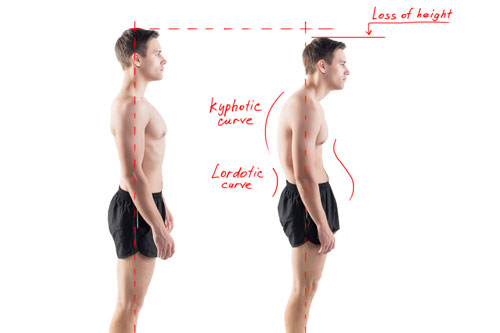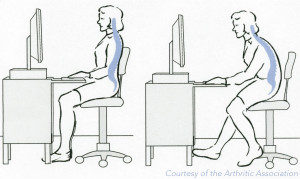Rounded Upper Back: Causes and Prevention of Kyphosis
- Category: General
- Posted On:
- Written By: Dr Craig Popp

What is Kyphosis?
In school we were taught about the evolution of man. We started as hunched over mammals that walked using all fours. As time passed and our species evolved, our spine slowly started to develop to allow for a straighter, more upright posture. Our current day spine is meant to be properly aligned when in a subtle S-shape.
Kyphosis is a deviation of the slight S-shape into a more dramatic curve that causes a rounded upper back. It is an unnatural curve that can effect portions of the spine or the entire spine.
What is Causing Kyphosis in Modern Day?
Cell Phones, Tablets, and Computers
Bad posture can loosen the ligaments in the spine. Over time this loosening can cause the spine to curve unnaturally and a rounded upper back. For the first time in history, we are purposely sitting in poor postures for extended periods of time. Spending hours bent towards a computer screen is lending itself to a trend of Kyphotic curves in a younger population. Holding our devices such as cell phones and tablets for hours on end has created odd postures that are making our ligaments weaken prematurely.
Osteoporosis and Weak Bones
Nutrient weak diets, increases in average weight, smoking, and less time for exercise has led to higher rates of osteoporosis in a younger generation and more severe damage in the aging population. Osteoporosis causes a weakening and compression of the bones in the spine.
Trauma and Injury
Blunt force trauma, and damage to the ligaments, muscle, or bone in the spine is an additional cause of Kyphosis. The spine may heal improperly leading to further damage.
How to Prevent Kyphosis
Kyphosis is not always avoidable, but there are things that can be changed in day-to-day life to minimize risk.
Seated Posture at a Computer
Posture is the largest contributing factor to unnatural curving of the spine. When sitting at a computer position your monitor so the middle of the screen is at eye level and sit with your feel flat on the floor, legs uncrossed. Also ensure that your keyboard is placed at waist height to allow your elbows to rest near your body at a 90 degree angle.
Standing Posture
Something as simple as the way you stand can effect the long-term health of your spine. When standing, keep shoulders and back aligned, engaging stomach muscles to ensure proper alignment. If you need to bend over due to your chosen profession, use ergonomic aids to improve body position. Proper table and chair height can improve function.
Holding a Smart Phone or Tablet
Most people watch tv, surf the net, and play games on their smart phone or tablet in a hunched over position. This can cause neck pain, stiffness, and long-term damage. Next time you are using a device try to keep it in a more forward-looking position.
Calcium + Vitamin D + Magnesium
The modern American diet is wreaking havoc on bone health. Many foods that are consumed on a daily basis lack nutrient density and block proper absorption of key vitamins. Gone are the days where large quantities of milk in one sitting are recommended for healthy bones. Science now recommends spreading out calcium intake throughout the day, and pairing certain food for optimal calcium absorption.
For calcium to reach optimal absorption it should be paired with foods rich in Vitamin D and Magnesium. Green leafy vegetables such as kale, collard greens, and broccoli have as much calcium as cows milk yet are more readily absorbed by the body. Good sources of Vitamin D are mushrooms and salmon. Oats, almonds and cashews are tasty sources of Magnesium.
A good breakfast idea for optimal calcium intake may include oatmeal with almond milk with crushed up cashews on top. A side of a kale and mushroom omelet would be a great way to pair for a healthy level of calcium that is easily absorbed by the body.
Exercise
Not all exercise is created equal when it comes to building bone strength. Weight bearing exercises are key to healthy bones long term. However, weight bearing does not mean having to do heavy lifting. Exercises such as yoga and pilates leverage weight bearing techniques using your own body weight. This is ideal because it is easy on your body’s joints while using enough of your own body weight to stimulating bone regrowth. Water aerobics is a great choice for those who already struggle with deteriorating bone diseases such as osteoporosis.
Smoking, Sodium, Protein, & Caffeine
Smoking, over consumption of caffeine, too much protein, and high levels of sodium are by far four of the most damaging things to your bones.
Smoking blocks the absorption of calcium and other important nutrients from bone. Smoke also causes inflammation in the body which agitates areas of your body that are already prone to pain by inflammation.
Sodium can be found in surprisingly high amounts in foods we eat everyday. Cereals, pre-made rices & pastas, cake mix, and breads may have more hidden sodium than the typical consumer realizes. Too much sodium lowers the amount of calcium the body can absorb and increases the amount of calcium excreted.
Protein is needed for energy and many other important functions in the body. However, overconsumption produces higher levels of sulfates. Sulfate in turn increase the amount of calcium the body excretes, lowering absorption.
Kyphosis is becoming more prevalent due to our modern lifestyle and our longer life expectancy. Taking precaution at a younger age can help prevent more dramatic formation of Kyphosis. Once damage has occurred there are options for slowing down the long-term effects of a curved spine.
To learn more about treatment options, contact Dr. Popp and his team to set up an appointment at: (630) 584-1400.






